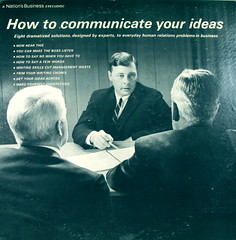Communication VS Conversation
 Although communication is defined as “the imparting or interchange of thoughts, opinions, orinformation by speech, writing, or signs” we often lean heavily toward the “imparting” and less on the “interchange,” or one-way vs. two way.
Although communication is defined as “the imparting or interchange of thoughts, opinions, orinformation by speech, writing, or signs” we often lean heavily toward the “imparting” and less on the “interchange,” or one-way vs. two way.
When we think of the term “Corporate Communications” or anything similar to that, it is one way. They push it to you. Almost never do you hear it used to imply two-way conversation.
In fact, I asked my wife about this and she always assumed that communication was two-way, or else it was not communication. Somehow, in the business world, we have stripped it of not only the second way but of genuineness. Communications that come from official channels (either from a manager with top down information to be dispersed or the whole organization) is not expecting a reply – in fact they engineer it in such a way that they HOPE they don’t get a reply. This often comes in the form of an email or poster. Is it any wonder that we all too often delete these messages without reading them and walk by the chameleon posters in the hall?
So, if we take this new definition not as it is on the books, but rather as we define it by practice, then we need to look back to a two-way communication – or conversation. This word connotes an expectation of a return dialogue or reaction. It engages both sides rather than makes one side feel good because they think they have communicated with the other side doesn’t even know it is happening.
Here is my suggestion, any time you hear the work COMMUNICATION, substitute it with CONVERSATION. When you think, “We need to communicate this to the employees,” instead say, “We need to have a conversation about this with the employees.” Instantly that does two things. 1) This becomes a two-way activity; 2) It has the potential to take more of your time – which is probably why most people only want to push communication rather than converse. It is a checklist instead of living real communication.
Yet when we do converse we go beyond what we think and find out what is really happening & how we can really help, we tap into a number of other benefits on many different levels.
Converse – don’t just communicate.
(Crossposted at EngagedLearning.net)
